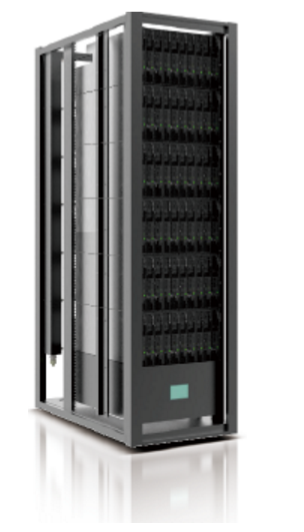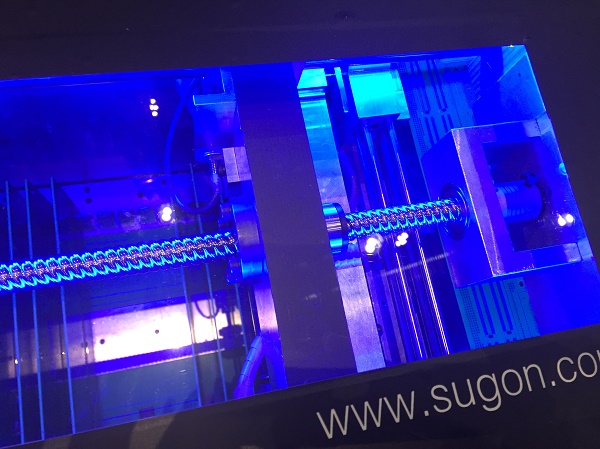One of the dominant themes of the latest TOP500 edition, released Monday in time for the opening of the SC15 show in Austin, was China’s leap in list share by number of systems; and one of the companies that has been pivotal in this push is Sugon (formerly Dawning). Sugon (the name means Super Dragon) and its primary Chinese competitor Inspur both have a strong presence at SC this year and both also have a targeted US focused go-to-market strategy, but Sugon has a unique challenge in that it is in the process of throwing back its academic and government cloak and stepping out into the Web-scale and enterprise light.
For most of its 20-year history, Sugon, a big HPC system builder for mainly government research installations, wasn’t commercialized; it was focused on key industries for the nation: science development, university research and strategic uses. At an interview in their booth on Monday, Sugon’s Vice President Joshua Wang explained that after Sugon was listed in the stock market one year ago, a mandate was handed down from the company’s primary shareholder (with a 33 percent stake), the Chinese Academy of Sciences: to start increasing commercial presence within China, while simultaneously expanding into the world-wide market. Wang said that the company launched this go-aboard program on the first of April and they have put together a complete team for the international market effort.
Sugon’s overarching strategy has some similarities to the IBM OpenPOWER play to crack the x86 juggernaut, but with a lot more control, which tends to be the Chinese way, and more right now due to a series of occurrences that have raised tensions in the political sphere. As part of a plan it calls “Open and Invest,” Sugon is availing its technology to its partners, and leveraging their distribution channels and servicing infrastructure to get into the global market. Sugon says it will control the technology and branding from the very beginning, essentially taking an investor position. With a steam roller approach, the company is already headed into neighboring economic regions: Southeast Asia first and then Russia. Wang recounts a solidified relationship with ECS Holdings Limited in Singapore that has resulted in their first external win with Macau University, which bought a 1,200-node system. Having the support aspects in place was critical to closing the deal, Wang said. Sugon is also partnering with Russia’s third-largest integrator, RRC, and that is ramping up.
The newly-commercialized company is also bringing in partnerships into China. As part of its push into the hyperscale cloud space, Sugon recently signed a major joint venture with VMware that facilitates their enterprise/Web push, and gives them some cash to boot. Note that Sugon’s “Open and Invest” approach is very similar to how VMware is penetrating China, but with a twist because Sugon maintains control over branding at home and abroad. It’s worth mentioning that VMware also has a major partnership selling into China through Inspur servers, so VMware is gaining market share and covering its bases.
Meet the Products
The major product area that Sugon’s new efforts are focusing on is HPC and the major industry is hyper-scale — the BATQ companies in their shorthand — meaning Baidu, Alibaba, Tencent and QQ. Now that these partnerships are starting to coalesce providing them with distribution channels and service solutions, Sugon has been able to start bidding for some of the projects outside China. The strategy is starting in the areas they identified (SE China and Russia), but they plan to duplicate it to sell into larger geographic areas and into HPC as well. In the year ahead, Sugon’s focus will be on HPC, hyperscale — and preparing their local team to roll-out this complete global strategy.

Sugon is using SC15 as a launch pad to let the HPC world know that they are ready to do business and have the end-to-end product set and related technologies for the markets they’ve identified.
At its booth, the team was showing off new pieces of a complete HPC and Web-scale focused hardware portfolio. This includes an innovative robotics-assisted liquid cooled solution, which will be covered below, and their TC4600E-LP liquid cooling blade system, which is a redesign of the air cooled TC4600E system (a core component of the Sugon 6000 series supercomputer).
The liquid-cooled blade system was designed to improve the energy efficiency of supercomputers to save the operational costs. The TC4600E that this is based on is Sugon’s 5th generation of blade system, one that is a core component of the Sugon 6000 series supercomputer. According to Sugon, TC4600E, which has a rack mount 5U chassis with 10x 2S blades per chassis, is “specially designed for HPC with high performance, high density, high reliability, low power consumption and wide applications.”
Now with LP, which has a rack mount 6U chassis with up to six chassis within a 42U rack cabinet, there is the option of having 10x 2S blades per chassis or 5x 2S heterogeneous blades plus 10x GPU or Intel Xeon Phi accelerators (Knights Corner installed, Knights landing coming up). The cooling method relies on a mix of liquid and air cooling with the processor and accelerator cooled by liquid and other parts by air. Power consumption is listed as a maximum 4kW for routine blades, 5kW for heterogeneous blades, and the PUE is a reasonable 1.1 for liquid cooling part 1.6 for air cooling part — about 1.2 for entire blade system.
Features the company is touting include:
- Energy Efficiency: reduces the power consumption of fan by 70 perecent and of air conditioning system by 80 percent, optimizes PUE to 1.2.
- Reliability: effectively lowers the temperature of main components, which helps to extend system life.
- Ultra Silence: within 45 dB due to very low fan speed.
- High Performance: supports latest generation of Intel Xeon E5-2600 v3 processors, GPU or Intel Xeon Phi accelerators, and FDR 56Gbps or EDR 100Gbps InfiniBand. Liquid cooling helps the frequency boost of processors and accelerators to gain an extra performance increase by 5 percent.
- Simplicity: no additional requirements for server room.
One of these liquid-cooled blade systems is already inside a prototype of the next Earth System Numerical Simulator, which has been designed around around three pillars: earth system science innovation, global disaster alerts, environment protection and human and nature sustainable coexistence.
Rounding out the top of this portfolio on the server side, Sugon has a TC5600-H Rack-scale Blade System, which it is characterizing as “a new server architecture for HPC…that is designed by Sugon’s R&D to deliver high performance, low TCO, high efficient cooling, quick deployment and easy operation.”
The features check all the the HPC boxes too:
- Latest generation of Intel Xeon E5-2600 v3 family.
- Latest EDR 100Gbps InfiniBand.
- Up to 80 compute nodes (80+ TFLOPS) or 40 storage nodes (1.8+ PB)
Sugon also offers both heterogeneous nodes as part of the Sugon 6000 series supercomputer that support the latest generation of most widely-used accelerators. “100 teraflops of performance per cabinet can be easily reached, and it scales up to 10-100 petaflops,” notes Sugon.
There’s also a Fat Nodes offering which features “outstanding single-node performance, extremely high memory capacity, ultra-high reliability to satisfy the needs of memory-hungry or mission-critical applications.” (Specs here.)
ParaStor200 Distributed Parallel Storage System, which is independently developed by Sugon’s R&D to handle massive data storage and processing needs, is storage server based and hardware-software integrated distributed parallel storage.
For system management, Sugon offers Gridview HPC Suite, an integrated monitoring, management and job scheduling software platform for HPC. Gridview is designed with several pluggable function modules that enables dynamic monitoring for the overall and detailed status of both computing center and cluster. Like much of their presented portfolio, this solution ticks all of the boxes that would be expected on a modern cluster management solution; capabilities include scheduling, accounting, workflow monitoring and Web portal functionality, but we’ll have to find some users to speak with before we get feedback on how this compares to other management software.
Robotic-assisted immersion server ejects motherboard like a CD drive
 The piece of the Sugon portfolio that scored highest for cool factor would have to be their brand-new liquid cooling product, which aims to address much of the inconvenience of submerged cooling. Sugon’s “Robo blades immersion server” is being presented as the world’s first automated immersion server — enabling up to 30 blades in one 19″ chassis. I didn’t time exactly how long it took, but after the request was sent, the machine ejected a completely dry disk in less than five minutes. The mechanical arm goes into motion, grabs one of the vertical motherboards (or mainboards if you prefer), unplugs it, “dehydrates” it and spits it out a slot in the front — very much like a CD rom, only the process is understandably more time-consuming.
The piece of the Sugon portfolio that scored highest for cool factor would have to be their brand-new liquid cooling product, which aims to address much of the inconvenience of submerged cooling. Sugon’s “Robo blades immersion server” is being presented as the world’s first automated immersion server — enabling up to 30 blades in one 19″ chassis. I didn’t time exactly how long it took, but after the request was sent, the machine ejected a completely dry disk in less than five minutes. The mechanical arm goes into motion, grabs one of the vertical motherboards (or mainboards if you prefer), unplugs it, “dehydrates” it and spits it out a slot in the front — very much like a CD rom, only the process is understandably more time-consuming.
 The system uses a two stage approach: the 3M coolant removes the heat rapidly, and warm water is cool enough to make the vapor condense. Key advantages touted by the company include high power density, high-cooling efficiency, high-density motherboard disposition, as well as low PUE because the technology utilizes the latent heat of vaporization to heat transfer, reducing PUE to 1.01-1.02. Besides addressing maintenance concerns, the robotic arm automatically pulls out and inserts the motherboard. An isolating compartment behind the slot in the front minimizes coolant vapor loss. “Robo Blades” is also extremely quiet being a fan-free design; at 35 decibels, it comes off as effectively “noise-free” compared to traditional datacenter cooling equipment.
The system uses a two stage approach: the 3M coolant removes the heat rapidly, and warm water is cool enough to make the vapor condense. Key advantages touted by the company include high power density, high-cooling efficiency, high-density motherboard disposition, as well as low PUE because the technology utilizes the latent heat of vaporization to heat transfer, reducing PUE to 1.01-1.02. Besides addressing maintenance concerns, the robotic arm automatically pulls out and inserts the motherboard. An isolating compartment behind the slot in the front minimizes coolant vapor loss. “Robo Blades” is also extremely quiet being a fan-free design; at 35 decibels, it comes off as effectively “noise-free” compared to traditional datacenter cooling equipment.






























































